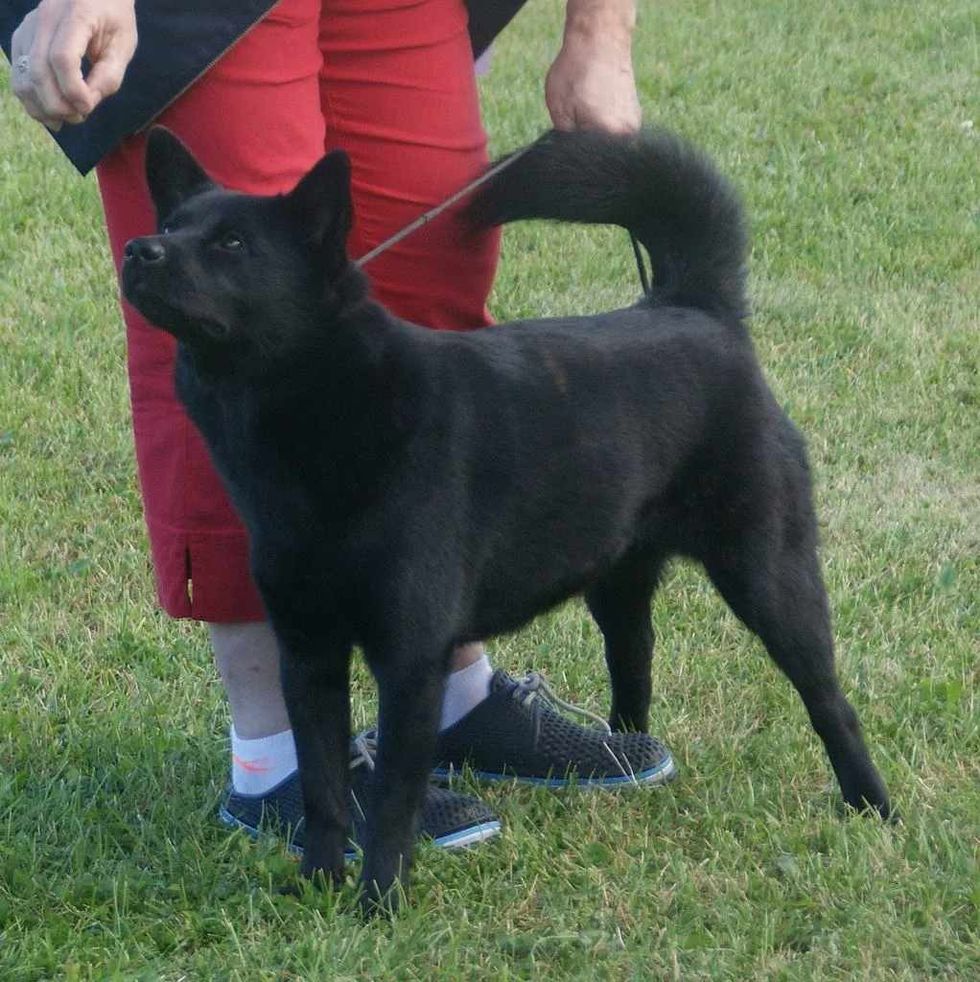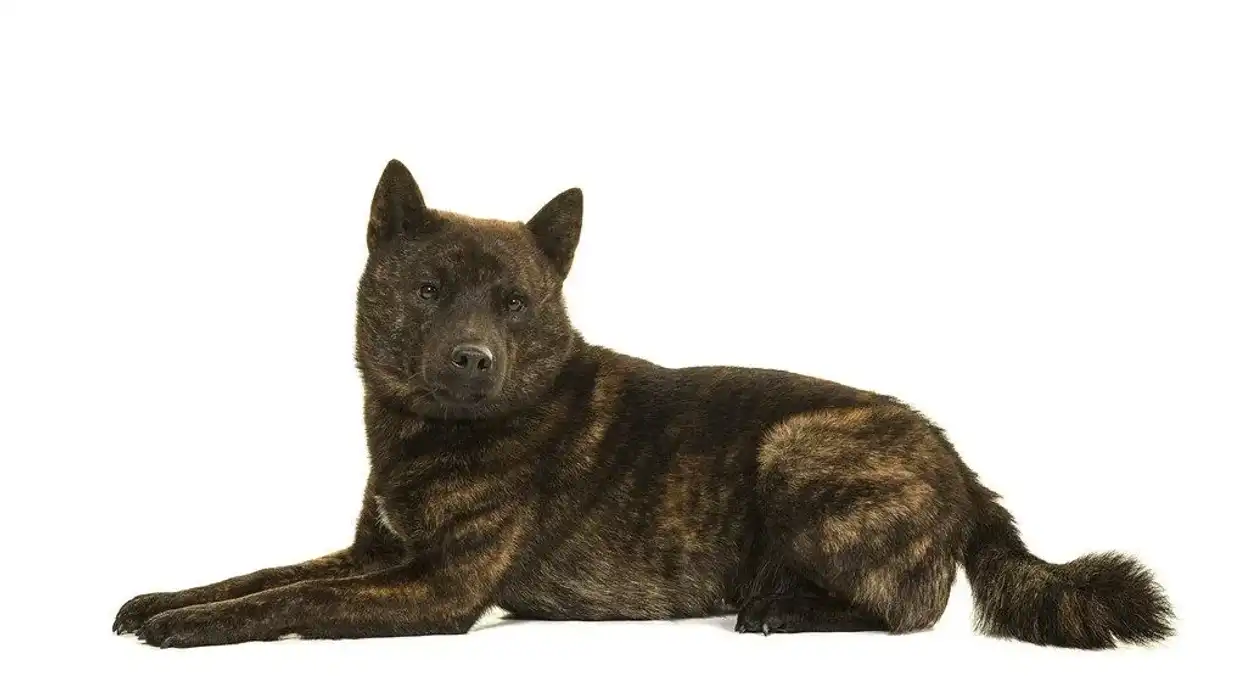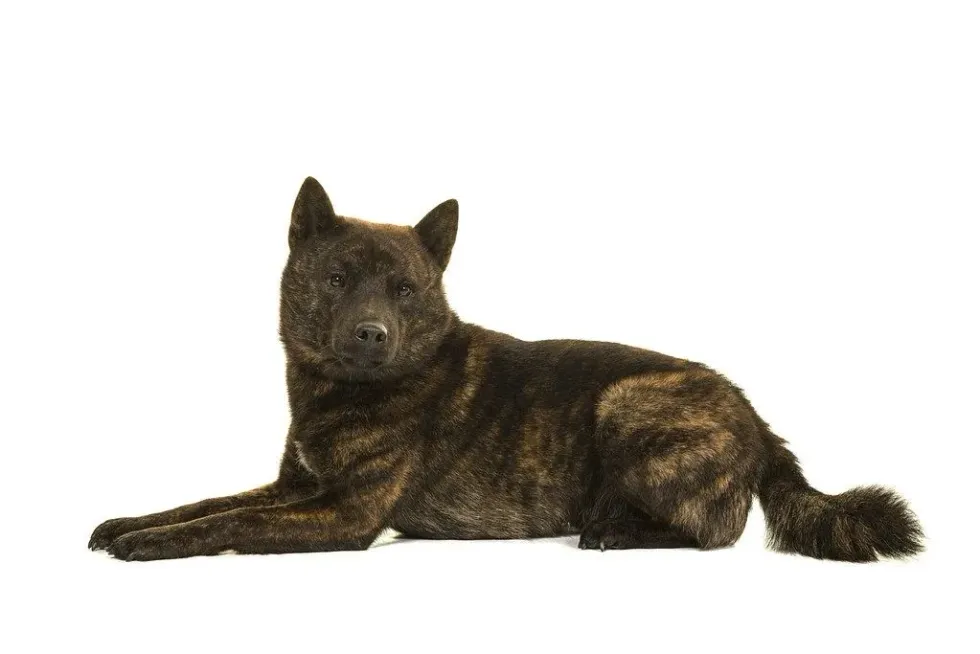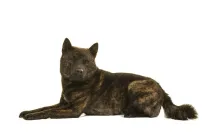Fun Ken Kai Facts For Kids

Content
- What type of animal is a Ken Kai?
- What class of animal does a Ken Kai belong to?
- How many Ken Kais are there in the world?
- Where does a Ken Kai live?
- What is a Ken Kai's habitat?
- Who do Ken Kais live with?
- How long does a Ken Kai live?
- How do they reproduce?
- What is their conservation status?
- What do Ken Kais look like?
- How cute are they?
- How do they communicate?
- How big is a Ken Kai?
- How fast can a Ken Kai run?
- How much does a Ken Kai weigh?
- What are their male and female names of the species?
- What would you call a baby Kai Ken?
- What do they eat?
- Are they slobbery?
- Would they make a good pet?
- Did you know...
- Comparisons with similar dogs
- Why are Kai Ken dogs rare?
The Kai Ken is one of the rarest and most interesting dog breeds you could run into.
Certified as a pure breed by the Japanese Kennel Club, the Japanese "Tiger Dog" is known across Japan and the world for more than just its double coat, its inches, weight, height, and all.
The Kai Ken is also known for its difficult training, its assimilation into a human family, and its journey from reserved puppies in a kennel to intelligent, alert, aware, and family-oriented breeds that will forever stay loyal.
Though they are reserved and require some natural care and training (especially for their coat), the Tiger Dog will outperform almost any other breed when it comes to a hunt or sports or any physical training.
So please read on to know more about this breed of dog that was once the master of the hunt but now spends its life playing human sports, natural training, and of course, being one of the most well-known in Japan. Are you interested in the Kai Ken?
Then why not check out the French Brittany and Petit Basset Griffon Vendeen too after reading this article.
Ken Kai Interesting Facts
What type of animal is a Ken Kai?
The Kai Ken is a type of dog.
What class of animal does a Ken Kai belong to?
Like all other dogs, the Kai Ken belongs to the mammal class.
How many Ken Kais are there in the world?
It is estimated that there are about 14,000-16,000 Ken Kais in the world.
Where does a Ken Kai live?
The natural habitat of the Kai Ken is the woods and mountains. They are said to have originated from the Kai mountains in Japan and have been named after them.
What is a Ken Kai's habitat?
The Kai Ken dog has its natural habitat in the woods and mountains of Japan. It prefers colder temperatures, space to move and exercise themselves, and the potential to hunt.
Their heavy double coat and temperature exposure as puppies used to protect them from the cold, but if they have been living with humans throughout their life (or taken out of Japan), then they might lose this ability and be at risk of health issues.
Who do Ken Kais live with?
Though the Ken Kais are very sociable animals, they do not live in packs. They prefer to live and hunt on their own in the Kai mountains in Japan.
However, in present days, they are mostly found living with people.
As a dog breed, they are intelligent, have an even and loyal temperament, and are friendly with those they see as their familiars.
They are great with older children and people in general but should be kept away from smaller animals like birds, mice, and cats among others because their hunting instinct only grows from the day they are born as puppies in a kennel.
How long does a Ken Kai live?
On average, the Kai Ken dog lives for around 12-16 years. However, if you look after their health and ensure that they get the kind of sports activities they need, you can extend their lives somewhere around 20 years.
If in good health, they do they live that long, but it depends entirely on how well you can take care of your Ken Kai Ryu.
How do they reproduce?
The Kai Ken reproduce by mating or breeding, after which the female usually gives birth to a litter of two to four Ken Kai Inu puppies. Unfortunately, a lot of times, the Kai Ken puppies do not survive.
This may be because of harsh climates, poor nutrition, or just weak genetics. In recent times, however, organizations such as the Kennel Club have noticed this plight.
They have been working with health officials to revive the species (particularly the black Kai Ken.) Also, trained breeders are also involved in helping Kai Ken reproduce and give birth to more healthy babies.
What is their conservation status?
Though the IUCN Red List has not evaluated them yet, they are one of the six rare breed dogs under the protection of the Nihon Ken Hozonkai (The Association for the Preservation of the Japanese Dog).
These six native Japanese dog breeds include the Kai Ken, the Shiba Inu, the Hokkaido, the Shikoku, and the Kishu, and it is the Nihon Ken Hozonkai that decided to make the Kai Ken a national living monument in 1933.
However, in 1931, the Kai Ken Aigokai was formed, which was a society dedicated to the protection of this dog breed.
It continues to work till this day.
Ken Kai Fun Facts
What do Ken Kais look like?
The Kai Ken is a very well-built dog. It is a medium-sized dog and has pricked ears.
This breed can come in a red brindle or a black brindle, depending on various factors. The red brindle is the Aka-tora, whereas the black is the Kuro-tora, and if the dog is colored somewhere between these two, then we call it the Chu-tora. The black is the most common among the Kai Ken.
They have tiger-like stripes on their double coat fur (for which they are called the Tiger dog), which are not present in the younger dogs but show up and become more apparent as they grow in height and weight.
The Kai Ken's wedge-shaped head makes them stand out as a rare breed as one of the six dog breeds protected by their native country.

How cute are they?
Like many other dogs, the Kai Ken is a cute little doggo indeed! This Japanese dog is the perfect companion for your household and looks simply adorable. Though they are reserved with strangers and don't do too well with children, you can watch their temperament change to one of an absolutely adorable puppy as you develop a bond.
How do they communicate?
The Kai Ken communicates just like any other dog would. They bark, growl, huff, whimper, call, and even yip when excited. These breeds do not communicate a lot, but they make sure you know it when they do. They are full of energy with an intelligent temperament, and their communication reflects that energy.
How big is a Ken Kai?
Then Kai Ken has a height that can come up to 18-22 in. The females are usually smaller than the males.
That makes the Kai Ken two-thirds the size of a Rhodesian Ridgeback, a breed well known for its ability to take down a lion. While the Kai Ken may not be able to take down a lion just yet, they can still hunt smaller game like deer, wild boards, rabbits, sheep, and goats.
How fast can a Ken Kai run?
This breed of dog can be run just as fast, if not faster, than its fellow Japanese dogs. Before it became a companion dog, breeds such as this were used as hunting companions, and with their high energy, they make a very good speedrunner.
How much does a Ken Kai weigh?
Coming in at 18-22 in, weight-wise, you can expect this breed of dog to be somewhere around 25-45 lb. Kai Kens are relatively light compared to other Japanese dogs because of their history as hunting dogs and needing to keep their body weight low.
This differs across various breeds and dogs, for some of whom the coat becomes a majority of their weight and height both.
What are their male and female names of the species?
The male and female of the breed do not have any new names. However, if we rely on the dog breed terminology, we can infer that a male would be called a dog, while a female would be referred to as a bitch.
If we want to dig a little deeper into facts, you can find out why Kai Ken has been named as such. Ken is the Japanese name for "dog," and Kai is the mountain where they were thought to be originated.
What would you call a baby Kai Ken?
A baby Kai Ken can be called a puppy, like every other baby dog. There is no specific name for the Kai Ken breed, but who knows, maybe sometime in the future, you could give specific names to these breeds' babies!
However, you must keep in mind that just because they are puppies does not mean you can take it easy. Family training starts when they are puppies, including grooming, exercise, sports, and care.
If not, they may spend their entire life as reserved dogs who do not do well even with their owner around. This would be a great shame for a naturally intelligent dog like the Kai Ken.
What do they eat?
This dog breed must be fed good quality food.
Poor quality kibble or human food will not only cause Kai Ken various stomach issues, but they will also make them weak, grouchy, and unable to move well.
In the wild, the Kai Ken is mostly carnivorous, eating raw meat and hunted prey like the wild boar, but they should be feed high-quality meat as much as possible at home.
This will help maintain your Kai Ken and his coat and help them stay healthy.
This may sound expensive, but having a Ken Kai puppy at home is even more expensive. With prices for a puppy starting at $2000, everyone can agree that this is a medium-sized dog is a rare breed indeed.
However, you should note that you should always look to adopt them, and not shop for them, because not only will you give a dog a good home, you also save on the purchasing costs.
Are they slobbery?
No, the Kai Ken is not slobbery at all. They may drool a little on occasion, but that is to be expected of every dog now and then.
They do not slobber a lot because they were used for hunting animals, and slobbery dogs make poor biter.
But just because they do not slobber does not mean they do not need the training to fit into the family and children. They may be intelligent and good with the children, but they are also stubborn and require extensive grooming and training, a firm owner, and lots of exercises.
Would they make a good pet?
The Kai Ken would make an excellent companion, but only under certain circumstances. They have to be exercised a lot.
The Kai Ken used to be dogs used to hunt, which means they had very high energy levels. Now that they are not used for hunting anymore, potential owners must find a way to keep them occupied. If they are not exercised well, the Kai Ken can turn destructive.
It is recommended that the Ken Kai dog be taken on hour-long runs and at least three sessions of 20-minute exercises every day. Kai Ken would appreciate any other toys you can gather for their entertainment.
In addition to good food and good exercise, the Kai Ken also requires heavy grooming. They have a double coat, which means they shed a lot and have to be constantly cleaned up after to make sure their health stays in top shape.
If you have trouble keeping up, then do take your Kai Ken to a vet regularly (once in every three months) and a groomer twice a year. They will help maintain your Kai Ken and its coat and do regular health checkups and help you create an exercise and diet plan that works for your Kai Ken Inu.
So are the Kai Kens high maintenance dog breed? Yes, they definitely are. But if you keep up with their grooming, their health, and their exercise and diet, there is no reason you can not make the perfect owner for a Kai Ken dog.
Did you know...
Kai Ken's role in popular media is more than what we give them credit for. There is a Japanese series called 'Ginga: Nagareboshi Gin' with a sequel 'Ginga Densetsu Weed'. Created by Yoshihiro Takahashi, this series features multiple Kiai Ken in the lead and side roles.
Some notable characters of this series are Kuro Tora Inu, Chu Tora Inu, and Aka Tora Inu. Every single one of these dogs is a Kai Ken. Talk about representation!
Not just good characters, the Kai Ken can also play evil characters. In another manga by Yoshihiro Takahashi, a Kai Ken is featured in a negative role called Gama.
However, if you choose to adopt one, we promise that the Kai Ken will be one of the sweetest dogs you will ever train. There are also several video games where you can play as a Kai Ken. A game released in 2004 had this dog as the main character, which was playable by everyone.
Comparisons with similar dogs
There are some integral differences between the Shiba, the Kai Ken, and the Ainu (also called the Hokkaido.)
The Hokkaido is usually less smart, but make up for it in docility and bravery. They are lighter in color, usually shades of white, brown, or a caramel-cream shade, unlike the Kai Ken which has a much darker coat.
They also have a tapered jaw and a sharper snout than the Kai Ken, which makes distinguishing them easier. The Hokkaido is also fluffier than your average Kai Ken dog because instead of two coats, this species has only one, very fluffy coat.
The Shiba is the smallest of the Kai Ken and the Hokkaido. They are small to medium-sized dogs and have the smallest size of all the native breeds of Japan.
This is usually enough to help you distinguish between the Shiba and the Kai Ken, but there are other markers too. The Shiba has a dual-colored coat, which is a light brown on top but has a white underbelly. This breed also has a tapered jaw and a sharper snout than the Kai Ken.
Why are Kai Ken dogs rare?
The Kai Ken are very rare dogs, even in their native land Japan. This is not a coincidence.
The first reason is why they are so rare is because they are not a human-bred dog, and were discovered naturally on the mountain of Kai (where this dog breed gets its name from), and were adopted into being a hunting dog.
They are a very rare and pure breed, and if it breeds with any other dog breed, the Kai Ken loses its pedigree.
Since the Kai Ken can not breed with any other breeds, their population remains out of human control. The second reason why the Ken Kai dogs are so rare is that they have very small litters.
Out of every litter, less than half survive. This dwindles the Kai Ken population a fair bit, though recently, humans are not only helping them breed but also ensure that the baby Kai Ken survives past its days of infancy.
There are a lot of conservation societies working to maintain the population of this noble Ken Kai dog, and you can help, even if you are not from Japan. You can spread awareness, read about these dogs, and donate to any organizations and societies that work to help them reach better numbers.
Here at Kidadl, we have carefully created lots of interesting family-friendly animal facts for everyone to discover! Learn more about some other mammals, including Boxer Lab Mix, or American Cocker Spaniel.
You can even occupy yourself at home by drawing one on our Ken Kai dog coloring pages.
We Want Your Photos!
More for You
See All
Bachelor of Arts specializing in English Language, Master of Philosophy

Devangana RathoreBachelor of Arts specializing in English Language, Master of Philosophy
Devangana is a highly accomplished content writer and a deep thinker with a Master's degree in Philosophy from Trinity College, Dublin. With a wealth of experience in copywriting, she has worked with The Career Coach in Dublin and is constantly looking to enhance her skills through online courses from some of the world's leading universities. Devangana has a strong background in computer science and is also an accomplished editor and social media manager. Her leadership skills were honed during her time as the literacy society president and student president at the University of Delhi.
Bachelor of Arts specializing in Psychology

Shreya YadavBachelor of Arts specializing in Psychology
Shreya has developed a diverse set of skills through her experience in client servicing, email marketing, content and e-commerce management, digital marketing, and creative content writing. Her educational background includes a Bachelor's degree in Psychology from Indira Gandhi National Open University, Delhi. Shreya's passion for ongoing learning and development is a testament to her commitment to excellence.
Disclaimer
1) Kidadl is independent and to make our service free to you the reader we are supported by advertising. We hope you love our recommendations for products and services! What we suggest is selected independently by the Kidadl team. If you purchase using the Buy Now button we may earn a small commission. This does not influence our choices. Prices are correct and items are available at the time the article was published but we cannot guarantee that on the time of reading. Please note that Kidadl is a participant in the Amazon Services LLC Associates Program, an affiliate advertising program designed to provide a means for sites to earn advertising fees by advertising and linking to Amazon. We also link to other websites, but are not responsible for their content.
2) At Kidadl, we strive to recommend the very best activities and events. We will always aim to give you accurate information at the date of publication - however, information does change, so it’s important you do your own research, double-check and make the decision that is right for your family. We recognise that not all activities and ideas are appropriate for all children and families or in all circumstances. Our recommended activities are based on age but these are a guide. We recommend that these ideas are used as inspiration, that ideas are undertaken with appropriate adult supervision, and that each adult uses their own discretion and knowledge of their children to consider the safety and suitability. Kidadl cannot accept liability for the execution of these ideas, and parental supervision is advised at all times, as safety is paramount. Anyone using the information provided by Kidadl does so at their own risk and we can not accept liability if things go wrong.
3) Because we are an educational resource, we have quotes and facts about a range of historical and modern figures. We do not endorse the actions of or rhetoric of all the people included in these collections, but we think they are important for growing minds to learn about under the guidance of parents or guardians.







